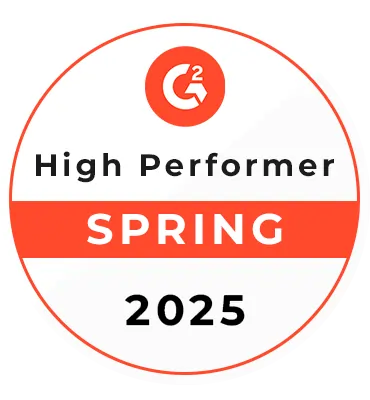User Interface Best Practices for Industrial Websites
Manish Kumawat
Last Updated on: 01 October 2025
The design of the user interface (UI) is an essential component of every successful industrial website. User interface (UI) design is one of the main things that user experience (UX) designers work on. The contribution of UI to the website's aesthetic appeal, engagement, and brand identification should be considered when you go for developing an industrial website. Let's look more closely at this topic here.
UI Design Elements for Industrial Websites
The essential components of UI design are as follows:
- Layout: The way UI components like menus, buttons, and text are arranged on the screen. A well-designed layout should be simple to use and comprehend.
- Color: The user's emotions and mood can be affected by the use of color in UI design. A good color scheme should convey the identity of the company and be aesthetically pleasing.
- Typography: The choice of fonts and their application on a screen. A well-designed typographic scheme ought to be readable and readable.
- Pictures: Provide visual interest and lend support to the text. They ought to be excellent and pertinent to the subject matter.
The UI Design Process for Industrial Websites
The creation of the final design is the last step in the multi-stage UI design process, which begins with research and analysis. The following are the main phases of UI design:
- Investigation and evaluation: Understanding the wants, preferences, and behaviors of the user in addition to the aims and objectives of the organization is necessary for this stage.
- Ideation: This phase entails coming up with concepts for the design, including the arrangement, color palette, font, and imagery. Drawing and brainstorming are used to accomplish this.
- Wireframing: Producing a low-fidelity model of the design, such as a wireframe, to illustrate the interface's fundamental composition and structure.
- Prototyping: Creating a high-fidelity model of the design, such as a clickable prototype, to demonstrate the interactive elements and user flow.
- User testing: Testing the design with actual users to find any usability problems and gather input on the design.
- Refinement: Making design modifications in response to user input and testing outcomes.
- Production: Bringing the design to a close and getting it ready for development are the tasks of this stage.
Key Principles of Industrial Websites UI Design
The following are some fundamental ideas that should direct your UI design:
- Simplicity: Make sure the design is user-friendly and basic. Keep things simple and unneeded.
- Consistency: To create a united and cohesive experience, use consistent visual components (color, font, and layout) throughout the interface.
- Clarity: Ensure that the design is clear and conveys its intended message. When users interact with the UI, utilize descriptive labels and give them feedback.
- Flexibility: Create an interface that can adapt to various device kinds, screen sizes, and resolutions. Ensure that the design is flexible enough to adjust to various settings and user requirements.
- Accessibility: Make sure that people with disabilities, such as those who are blind or have motor impairments, can utilize the design. Make sure the UI is keyboard shortcut navigable, use suitable color contrast, and include alternative text for photos.
Common UI Mistakes to Avoid While Designing for Industrial Websites
Try to avoid the following common mistakes while designing your manufacturing website:
- Inadequate space and padding: Ultimately, the most problematic situation arises when site designers neglect to include appropriate padding and spacing between interface elements. Because text material on tiny format devices is so small that it cannot be read without zoom, even adaptable and adaptive layouts may not be able to be utilized.
- Excessive style: The overabundance of items on web pages has previously been discussed extensively. We will just draw attention to the fact that, in the case of experimental web design that is created from scratch, "less is more." Keep in mind that this may cause people to become confused in addition to being ugly.
- Poor font: Let's discuss the experimental fonts that certain websites employ to highlight the uniqueness of their designs. Initially, they frequently "float" on user devices with non-standard sizes. Second, because the font will identify your work as being someone else's, you run the risk of creating a pitiful copy-paste job of their design when you employ a non-unique typeface. For this reason, when it comes to font selection, it's usually preferable to go with something neutral.
- An excessive amount of text:One of the unstated trends of the late 1990s, when the Internet was still in its early stages, is websites with a lot of text content. Currently, infographics have replaced this tendency as they can convey the great majority of difficult concepts in a clear and easy-to-understand manner without causing customers undue inconvenience. For this reason, hiring a designer to provide educational graphics for your website is preferable to making your visitors read a lot of text.
- Inconsistency in the design:Although it can seem like an odd error to make, doing so frequently leads to a bad user experience. Inconsistent website design might lead to visitor confusion and reduce the effectiveness of your information. Your visitors might not realize that two pages are part of the same website if, for instance, one page has a blue header and the other a green header. Visitors may become confused as a result and be unable to completely comprehend your good or service.
- Ineffective design:You could wish to go with a modern style that incorporates simplicity and minimalism when creating a new website. Making a layout that isn't responsive, though, can be a mistake. On mobile devices, an unresponsive design is not user-friendly. When users attempt to access your website on their mobile phones, this may irritate them.
- Unfriendly CTAs: Unfriendly CTAs with large amounts of CTA words on buttons and other small format elements are another prevalent issue. Calls to action so appear untrustworthy, and all textual content therein becomes utterly unappealing to users. This is why it's occasionally a good idea to leave some white space and allow content managers to use their creativity when crafting CTAs.
- Poor visual hierarchy: The arrangement of the content that your visitors see is known as the visual hierarchy. For instance, the visitor will view the image of your product first if it is positioned before a piece of text. They will then read the passage. This can work well since it enables users to swiftly scan the page and find the most important content.
- Not testing: Finally, failing to test your website with actual users can prove to be a huge error during the design phase. It's critical to keep in mind that the end user is the one for whom the website is being developed and to ensure that the functionality and design fulfill their requirements, it's imperative to solicit their insightful feedback. Real user testing can be used to find usability problems that the design team might not have seen. For instance, a layout that is fantastic on a computer screen could not be optimized for mobile devices, or a button or link that appears obvious and straightforward to the designer might confuse users.
Best Practices for Manufacturing Website UI Design
The best practices to consider when creating the user interface are as follows:
| Best Practices | Description |
|---|---|
| Grid System | To guarantee layout balance and alignment, use a grid system. |
| Small Color Scheme | For a unified and recognizable visual identity, stick to a small color scheme. |
| Typography Hierarchy | Apply hierarchy and focus to your typography. |
| Icons and Pictures | Create a more visually appealing interface by using icons and pictures to help communicate information. |
| White Space | When highlighting key components and fostering a feeling of openness, use white space. |
| Uniform Visual Identity | Maintain a uniform visual identity across the website for a professional appearance and recognition. |
| Clear Call-to-Action Buttons | Use prominent and clear call-to-action buttons to guide users toward desired actions seamlessly. |
| Responsive Design | Optimize the website for various devices to ensure a consistent experience across all screen sizes. |
| Quick Loading Pages | Ensure quick loading of pages to improve user experience and reduce bounce rates. |
| Straightforward Forms | Design forms that are straightforward to encourage user interaction and data collection. |
Example of an Effective Industrial Website
Gear Tech
The industrial website of Gear Tech Manufacturing Company is designed by Fulminous
Software’s top-class web designers.
Key Features:
- Gear Tech's website excels in providing a vast amount of technical information in a structured and accessible manner.
- Attractive landing page
- Fast Loading
- Smooth Navigation
- Responsive Design (Mobile-friendly)
- The site is well-organized with good navigation, detailed product pages, and powerful search functionality.
- Leading rank in search engines.
- High-quality visuals and downloadable resources are easily accessible.
Get Your Manufacturing Website UI Design Today
We are the finest choice for enhancing the UX design of your website as we understand the particular demands of manufacturing companies. Fulminous Software offers flexible scheduling and affordable rates for hiring excellent UI/UX designers to enhance the user experience on your manufacturing company website. Get in touch with our experts right now.
FAQs
- Q1: What are the key elements of UI design for industrial websites?
- A: Essential UI elements include layout, color, typography, and visual elements. These ensure the website is aesthetically pleasing, easy to navigate, and effectively showcases your product or service.
- Q2: What are the steps in the UI design process for industrial websites?
- A: The steps are research, ideation, wireframing, prototyping, user testing, refining, and production. This process helps design a functional, user-friendly site where visitors can easily find the information they need.
- Q3: What common UI mistakes should be avoided in industrial website design?
- A: Avoid inadequate spacing, excessive styling, poor fonts, too much text, design inconsistency, ineffective responsiveness, unclear CTAs, poor visual hierarchy, complex navigation, and lack of user testing.
- Q4: What are the best practices for designing the UI of a manufacturing website?
- A: Best practices include using a grid system, maintaining a cohesive color scheme, applying typography hierarchy, using icons and images, incorporating white space, ensuring consistent visual identity, and responsive design.
- Q5: How can UI design improve the user experience on industrial websites?
- A: UI design enhances user experience by making the website easy to navigate, ensuring intuitive access to product or service information, and improving engagement through effective visual elements.
- Q6: Why is responsive design important for industrial websites?
- A: Responsive design ensures that industrial websites are accessible and functional across all devices, enhancing user experience and making it easier for visitors to find information regardless of screen size.
- Q7: What role does color play in UI design for industrial websites?
- A: Color helps convey brand identity and enhances visual appeal. It should align with the industrial market’s branding and improve user engagement by making the site more attractive and easy to navigate.
- Q8: How can social media integration enhance UI design for industrial websites?
- A: Social media integration can drive traffic, improve engagement, and enhance brand visibility. It allows users to share content and interact with your brand, making the website more dynamic and connected.
- Q9: What should be considered when using visual elements in industrial web design?
- A: Visual elements should support the content, align with brand identity, and enhance the overall design. They should make the site more engaging and help users quickly find the information they need about products or services.
HIRE A TOP SOFTWARE DEVELOPMENT COMPANY

 Verified
Expert in Software & Web App Engineering
Verified
Expert in Software & Web App Engineering
I am Manish Kumawat, co-founder of Fulminous Software, a top leading customized software design and development company with a global presence in the USA, Australia, UK, and Europe. Over the last 10+ years, I am designing and developing web applications, e-commerce online stores, and software solutions custom tailored according to business industries needs. Being an experienced entrepreneur and research professional my main vision is to enlighten business owners, and worldwide audiences to provide in-depth IT sector knowledge with latest IT trends to grow businesses online.
Partner with Top-Notch Web Application Development Company!
Discuss your Custom Application Requirements on info@fulminoussoftware.com or call us on +1-903 488 7170.
15 Days Risk-Free TrialRecommended Articles


